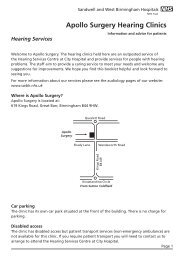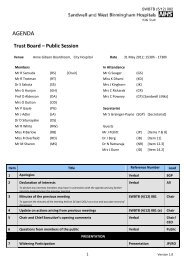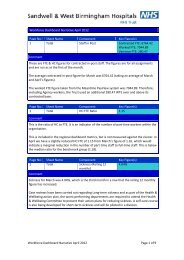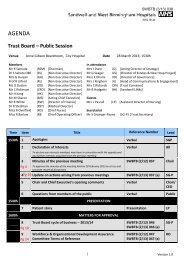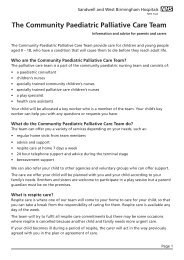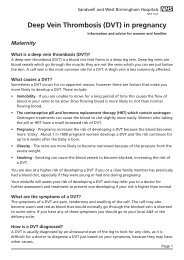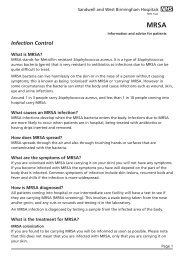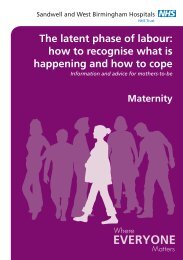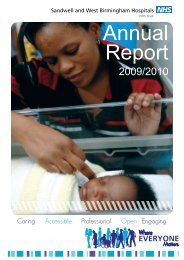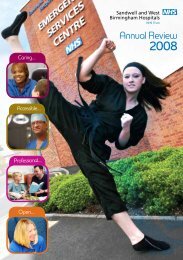January 2012 - Sandwell & West Birmingham Hospitals
January 2012 - Sandwell & West Birmingham Hospitals
January 2012 - Sandwell & West Birmingham Hospitals
You also want an ePaper? Increase the reach of your titles
YUMPU automatically turns print PDFs into web optimized ePapers that Google loves.
SWBTB (1/12) 286 (a)<br />
Appendix 2<br />
LONG LIST OF OPTIONS<br />
The long list of 6 service model options is described below. It should be noted that these are<br />
service models and as such are not specific about hospital site.<br />
Option 1a<br />
Continue with the current service model ‘Do Nothing’- not considered viable due to inability to<br />
meet WMQRS standards to provide 24/7 service, and then clinical risks associated with this.<br />
The risks and issues of this option are fully articulated in the project’s Clinical Case for<br />
Change report and summarised in the section 2.3 above.<br />
Option 1b<br />
Retain the current configuration but introduce new ways of working for medical teams in order<br />
to provide acceptable level of cover at all times- not considered viable within a suitable<br />
timeframe, or sustainable due to medical staffing numbers, their clinical commitments and the<br />
ability to retain and recruit high calibre staff. This model would not achieve critical mass and<br />
would require extra support from nurses, who would require specialist training, which can only<br />
be achieved through a full training programme and clinical mentorship. This would take<br />
considerable time to implement and therefore there would be a delay in the ability to provide<br />
full 24/7 services. The issues raised are explained in the Clinical Case for Change report for<br />
Stroke and TIA services (SWBHT March 2011).<br />
Option 2<br />
Configure a two site model with all emergency hyper-acute care delivered from one site<br />
including the ability to review high risk TIA 24/7. There would also be short stay stroke beds<br />
at this site as part of continuing care within the stroke unit.<br />
Long stay rehabilitation would be delivered at the second site along with OPD clinics<br />
including all follow up and also specific dedicated clinic slots for low risk TIA.<br />
The centralisation of Hyper-acute stroke services will enable patients to have rapid access to<br />
the right skills and equipment and be treated 24/7 on a dedicated stroke unit, staffed by<br />
specialist teams. Hyper-acute units have a number of dedicated assessment beds available<br />
with full cardiac monitoring facilities and appropriate staffing for level 2 monitoring and also a<br />
number of dedicated stroke in-patient beds for short stay. (All alternative Options, that is,<br />
options 2-6 include the development of a Hyper-acute Unit on one site only as this was<br />
a non-negotiable within the project).<br />
Option 3<br />
This is a single site model with all facilities and services located at one site. All hyper-acute,<br />
rehab, imaging and OP services would be provided on the one site, with nothing provided on<br />
the other site. It provides a 24/7 service and incorporates neurology beds within the hyperacute<br />
area. Short and long stay rehabilitation would be provided in a dedicated stroke rehab<br />
ward located at the same site near to the hyper-acute unit.<br />
There would be a telemedicine link from the ED department to the Hyper-acute facility. In<br />
addition there would be early supportive discharge assessment and intervention available on<br />
site from the earliest opportunity.<br />
All TIA patients would be managed on an outpatient basis. TIA services would be enhanced<br />
via inclusion of a telemedicine approach from the Hyper-acute Unit to ED.<br />
Option 4<br />
31




